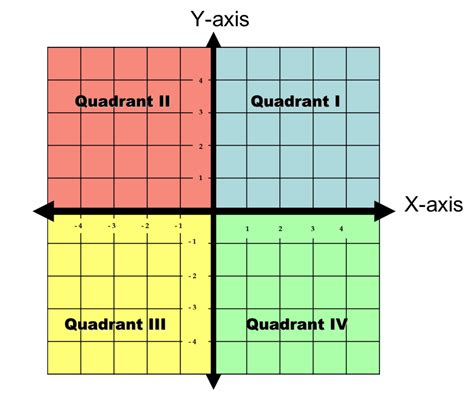Unlocking the Quadrants: A Comprehensive Guide to Strategic Success
Introduction
In the realm of strategy and decision-making, the concept of quadrants serves as a powerful tool for analyzing and optimizing business operations. This comprehensive guide will delve into the intricacies of quadrants, empowering you to leverage this framework to achieve maximum impact.
Understanding Quadrants

A quadrant is a two-dimensional matrix that divides a space into four distinct areas. In the context of strategy, quadrants are typically used to categorize options, opportunities, or threats based on their importance and urgency.
The quadrants are commonly labeled as follows:
-
Important and Urgent (Quadrant I): These are matters that require immediate attention and decisive action.
-
Important but Not Urgent (Quadrant II): These are priorities that should be planned for and addressed in a timely manner to prevent them from becoming urgent.
-
Not Important and Urgent (Quadrant III): These are distractions that should be delegated or eliminated to free up time and resources for more critical matters.
-
Not Important and Not Urgent (Quadrant IV): These are activities that have little or no value and should be minimized or eliminated.
The Eisenhower Matrix
The Eisenhower Matrix is a popular quadrant tool developed by former US President Dwight D. Eisenhower. It categorizes tasks based on their urgency and importance, helping individuals prioritize their efforts effectively.
Determining Importance and Urgency

To accurately place items in the quadrants, it is crucial to assess both their importance and urgency.
-
Importance: Refers to the significance and impact of a task or opportunity on achieving long-term goals.
-
Urgency: Indicates the time-sensitive nature of a task or threat, requiring immediate attention to avoid negative consequences.
Example:
Consider the following task: "Negotiate a new lease for company headquarters."
-
Importance: High (essential for ensuring stable and cost-effective operations)
-
Urgency: Low (current lease expires in six months)
This task would be placed in Quadrant II (Important but Not Urgent), indicating that it should be planned for and addressed in the coming months to prevent it from becoming urgent.
Why Quadrants Matter
Effectively using quadrants offers numerous benefits, including:
-
Improved Prioritization: Helps allocate time and resources to the most important and urgent matters.
-
Reduced Overwhelm: Prevents feeling overwhelmed by focusing on the tasks that truly matter.
-
Increased Productivity: Encourages completion of high-value tasks, leading to greater efficiency and productivity.
-
Enhanced Decision-Making: Provides a structured framework for evaluating options and making informed decisions.
-
Improved Goal Achievement: Directs efforts towards achieving strategic objectives by prioritizing tasks that contribute to long-term goals.
Effective Strategies
To maximize the value of quadrants, consider the following effective strategies:
-
Regular Reviews: Periodically review and update your quadrant list to ensure it remains relevant and accurate.
-
Delegate Wisely: Assign tasks in Quadrants III and IV to others or eliminate them altogether to free up time for more critical matters.
-
Optimize Quadrant I: Focus on completing tasks in Quadrant I efficiently and effectively to mitigate potential risks and seize opportunities.
-
Plan for Quadrant II: Schedule tasks in Quadrant II and allocate resources to address them proactively before they become urgent.
-
Minimize Quadrant III: Actively avoid or delegate tasks that fall into Quadrant III to prevent distractions and improve productivity.
-
Eliminate Quadrant IV: Strive to eliminate or minimize activities in Quadrant IV, as they contribute little or no value.
A Step-by-Step Approach
Follow these steps to implement a quadrant system in your daily routine:

-
Identify Tasks and Opportunities: List all the tasks, projects, or opportunities you are facing.
-
Assess Importance and Urgency: Determine the importance and urgency of each item on your list.
-
Categorize into Quadrants: Place each item in the appropriate quadrant based on its importance and urgency.
-
Develop an Action Plan: Create an action plan to address tasks in each quadrant, prioritizing those in Quadrant I and II.
-
Monitor and Adjust: Regularly review your quadrant list and adjust it as necessary to reflect changes in priorities and circumstances.
Pros and Cons of Using Quadrants
Pros:
- Simple and easy to use
- Helps prioritize tasks and opportunities
- Reduces overwhelm and improves productivity
- Provides a structured framework for decision-making
- Enhances goal achievement
Cons:
- Can be subjective to personal interpretation
- May not capture the complexity of all situations
- Requires regular maintenance and updates to remain effective
Conclusion
Quadrants are a powerful tool for strategic planning and decision-making. By understanding the concept of quadrants and implementing the strategies outlined in this guide, you can unlock the potential of this framework to prioritize your efforts, maximize productivity, and achieve greater success.
Remember, the key to effective quadrant management is regular review and ongoing adjustment. As circumstances change, so too will your priorities. Be prepared to adapt your quadrant list accordingly to ensure it remains aligned with your goals and objectives.
